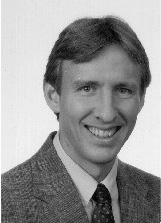

Todd Hubing
Associate Editor
Zero! Zip! Nada! That’s how many EMC limericks I’ve received since my appeal in the last Chapter Chatter column. Ok, perhaps EMC engineers are not natural limerick writers. After all we’re not poets, we’re puzzle solvers. When we encounter a product with an EMC problem, we regard it as a challenge – a puzzle to be solved. Those of us that enjoy our work probably also enjoy solving other kinds of puzzles. Therefore, this issue’s column is a puzzle. To solve it, cross out every word in the next paragraph that is the name of an EMC Society chapter city or country. Then, if you are a member of the IEEE EMC Society, circle the first word and every third word after that (skipping the words that have been crossed out). For example, applying this technique to the beginning of this column, the first three words circled would be Zero! That’s EMC. Decode the message by reading the circled words in order including punctuation marks. If you are not a member of the IEEE EMC Society, then circle the second word and every third word after that (again, skipping crossed out words). Applying this technique to the beginning of this column, the first three words circled would be Zip! How limericks. Got it? If not read the instructions one more time. Here is the puzzle:
If What?! Perhaps you you you are Atlanta are didn’t
reading not read this a the message, member directions
then of carefully. you the Go are EMC back
not Society! and only How try a Baltimore do again.
member, you Stop you keep it. are up Go
a with away! member this This who rapidly is Germany
reads changing not the field? the newsletter EMC message
and Society with therefore publications the you and words
are events sex well are and informed. valuable sexy
You’re sources in also of it. probably information Hello?
very France Society You intelligent, membership certainly savvy is are
and just persistent. a 15 Are tremendous dollars you
San Diego asset per lost to year or your for do
company. IEEE you If members. just everyone If like
on you to earth are solve Chicago were not other
like an people’s you, IEEE problems? the member, Either
world you way, would can you be become have
a Los Angeles an what more affiliate it compatible member takes
place. of to Also, the be the EMC a Phoenix
EMC Society great Italy Society for EMC would just engineer.
have 50 The over dollars IEEE four per EMC
billion year. Society’s members. EMC three Still Seattle Society main
with members publications, us? are the You well transactions,
must informed, the like valuable newsletter, puzzles. to and
Here’s their the another employers, Boston symposium one. and record
The very can first sexy. help word Well, you
of OK, to the not maintain Chapter necessarily an
Chatter sexy, expertise column but in is I EMC.
not wanted These chosen to Washington publications entirely use are
at the mailed random. words to If sex all
you and EMC review sexy Society old near members.
issues the We of end are the Santa Clara of an
newsletter this international you message society, may to but
be help there able motivate is to people no
see to chapter a solve in pattern. it. Beijing Rolla.
Too difficult? Here’s a helpful hint. After crossing out the names of chapter cities and countries, each line has exactly 9 words in it. Still too difficult? Bring the puzzle to your next EMC Society chapter meeting. Chapter meetings are a great place to get help with all your EMC-related puzzles.
Thanks to Bruce Crain, chair of the Atlanta chapter for submitting the following report.
The Atlanta chapter held a meeting on December 1, 1998 at the Lockheed Martin Aeronautical Systems (LMAS) facility in Marietta, Georgia. The speaker was Clayton Paul, who has recently joined the faculty of the Department of Electrical and Computer Engineering, Mercer University, Macon, Georgia. Dr. Paul presented “Crosstalk in Cables and Printed Circuit Boards” to a captivated audience. The presentation was interesting and enlightening to both the neophyte and “seasoned” EMC engineers in the audience. The Atlanta EMCS chapter is fortunate to have Dr. Paul as a member and we look forward to his participation in future chapter meetings.
It is with sadness that I inform you of the passing of Herb Zajac on November 11, 1998 after a 6-month battle with a brain tumor. Herb was the Vice Chairman of the Atlanta EMCS chapter and a member of the EMCS Board of Directors. Herb was a valued colleague and a trusted friend, especially to those of us at LMAS who worked with him daily. Our thoughts and prayers go out to his wife Linda, his daughters Wendy and Deanna and their husbands, and his 5 grandchildren.
Prof. Gao Yougang, chair of the Beijing chapter of the IEEE EMC Society reports that the 1998 National Meeting on Electromagnetic Compatibility was held on September 22-24 in Nanjing, China. About 90 experts and scholars throughout the country attended the meeting. They were from universities, research institutes, factories, companies and departments all over the country.
The meeting was called to order at 9:00 am on September 22 by Prof. Gao Yougang, the president of the EMC Society of China. A round of introductions was made and Prof. Gao was invited to give a report on “EMC Technology in Communications and Computers in the 21st Century.” Next Prof. Gao Benqing of the Beijing University of Science and Engineering presented his report. He noted that EMC technology is progressing rapidly in China. The last invited speaker, Prof. Cao Wei of the Nanjing Institute of Posts & Telecommunications gave a report on “The Environmental Pollution from Electromagnetic Radiation and Its Protection.” After the invited talks were concluded, the remaining talks were divided into theoretical and engineering sessions.
The talk on “The 3D FDTD Modeling and Calculation for Crosstalk Coupling in Transmission Lines” presented by Prof. Gao Benqing attracted many scholars. His method models transmission lines directly and doesn’t need to calculate the related impedances. Complete information about the electric and magnetic field coupling can be obtained to analyze the other characteristics of transmission lines.
Another popular talk was “Using Robot Mechanics to Calculate the 3D Field in the End-Windings of Large Generators” by Dr. Li Shufang. The reported method overcomes shortages in existing models by treating end-windings as many rectangular current elements, allowing the 3D distributed stator current in the end-windings to be modeled more accurately. The results have been used to design the hydraulic generator in the Three Gorge Hydraulic Power Station.
Following the above meeting, on September 25-26, the Meeting of the Foundation of Lightning and Electromagnetic Pulse (EMP) Sub-committee was held at the Nanjing Engineering College for Engineering Troops. Academic exchange activities were also carried out. Eight reports on lightning and electromagnetic pulse were presented. Among them were “The Numerical Calculation for High Power Microwaves” presented by research fellow, Chen Yusheng, and “The Engineering Protection for Nuclear Electromagnetic Pulse” presented by Prof. Zhou Bihua.
Thanks to the support of many experts and scholars from all over China, the two meetings above were very successful.
John Clarke reports that Michael Hopkins of KeyTek was the speaker at their September meeting. Mr. Hopkins topic was “Harmonic and Flicker Analysis.” This presentation provided manufacturers with a perspective pertaining to harmonic (IEC 61000-3-2) and flicker(IEC 61000-3-3) measurements, technical information about the tests, and test equipment needed. The speaker also discussed proposals for changes to the standards. This meeting was jointly sponsored with the North East Product Safety Society (NEPSS).
The October meeting featured Larry Stillings of Compliance Worldwide, who spoke on the subject of “Compliance vs. Compatibility with North American Digital Telecommunications Networks.” The presentation discussed the recently harmonized FCC Part 68 and Industry Canada CS 03 rules for digital telecommunications interfaces covering T1, ISDN PRI, ISDN BRI, DDS and ADSL. An outline of the tests was also covered.
In November, Donald R. Bush of dBi Corporation, an EMC Society Distinguished Lecturer, presented “A Brief History of EMC Measurements.” He discussed changes in both the technology and philosophy of EMC measurements that has taken place over the last 30 years. Some of the early experiences of the speaker and his colleagues were described.
Another EMC Society Distinguished Lecturer, Robert Dockey of Hewlett Packard, was the featured speaker at the December meeting. Mr. Dockey’s presentation was entitled: “New Techniques for Reducing Printed Circuit Board Common-Mode Radiation.” In 1993, Dockey discovered that a relatively small PCB with a solid ground-plane could also produce common-mode radiation. The speaker elaborated on these findings and described several methods that can be used to effectively mitigate the radiation mechanisms.
On December 7, a successful meeting of the Central and South Italy Chapter was held in Rome. The General Vice-Director of the Environment Ministry, Dr. Biondi, gave a Seminar on the new law (Nov. 1998) regulating the levels of electromagnetic field in the high frequency range (above 100 kHz) in Italy. These limits will be effective beginning in January 1999. Also, the evolving situation in the EC was presented and clarified. More than 100 people attended the conference. The 90-minute presentation was followed by many questions.
The Fall meeting of the Chicago chapter included a presentation from Don Bush of dBi Corporation. Don is an IEEE EMC Society Distinguished Lecturer. He spoke to the group on International EMC Standards. He described how many of today's EMC specifications evolved out of the FCC and CISPR committees. His historical approach to EMC shed an interesting light on the roots of EMC. In the end, he noted the proliferation of EMC standards and requirements for products. He found one electronic typewriter with 20 emblems or marks! He challenged the EMC community to coordinate their efforts. He was also concerned about the value of EMC requirements. Are they applied unnecessarily? Are limits too restrictive? There seems to be a minimal number of EMC complaints. Does that indicate that the requirements are overkill or that they are doing what they were intended to do?
The executive committee met in December to discuss future plans. Work is continuing on the chapter website and plans are being made for the symposium to be held in Chicago in 2005. Plans are also underway for a one-day mini EMC symposium sometime soon. This symposium will be designed to provide an educational opportunity for many of the members and serve as a showcase for many of the EMC companies in the Chicago area. Contact Derek Walton, Tom Braxton, or Frank Krozel for further information.
The good atmosphere of a successful beginning was felt when members of the German EMC Chapter met at the University of Magdeburg, according to Dr. Frank Gronwald. There the recently established EMC group features a newly installed shielded room (7.9m x 6.7m x 3.8m) which will primarily be used as reverberation chamber. Moreover, a GTEM-cell (EMCO 5317) is expected to arrive in Magdeburg no later than March 1999. These circumstances were taken by Profs. Juergen Nitsch and Guenter Wollenberg as occasion to organize two seminars, which were held in December 1998. In the first one, Markus Petirsch shared his valuable experience on reverberation chambers. In the course of his research and measurements, he investigated the details and characteristics of the reverberation chamber at the University of Karlsruhe. Thus, in turn, the audience went through a thick pile of transparencies and gained a solid knowledge of his work.
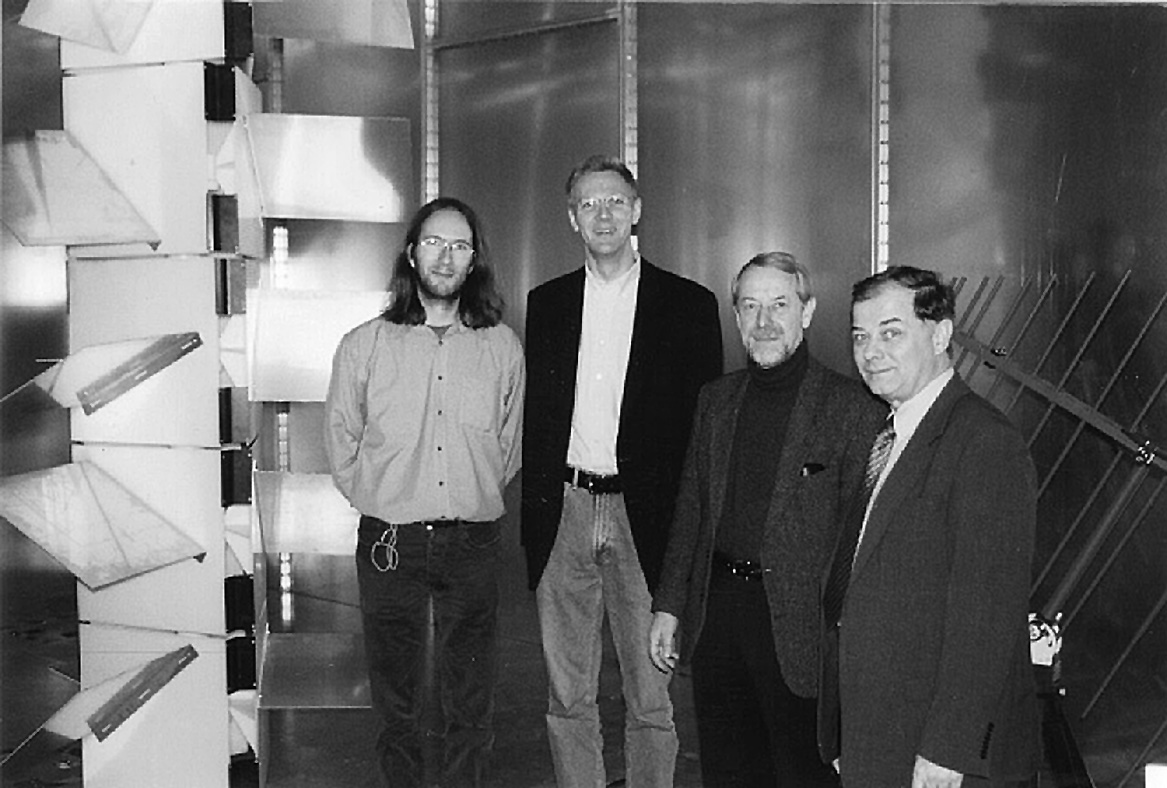
The German EMC Chapter is increasingly interested in reverberation
chamber test techniques.
Principal investigator Hans-Georg Krauthaeuser, Markus Petirsch, Juergen Nitsch, and
Guenter Wollenberg (left to right) are shown inspecting the new
reverberation chamber at the University of Magdeburg.
The second talk, by Michael Koch from the University of Hannover, was devoted to electromagnetic field computation in GTEM-cells. Michael Koch presented the impressive results of his Ph.D. thesis where he connected exact analytical computations to experimental data and numerical simulations. In both cases the discussion did not cease at the end of the session but continued to late hours in the Italian restaurant around the university corner.
The Mohawk Valley Section EMC Chapter held its last meeting of 1998 on December 3rd. Nearly thirty members and guests were in attendance for the luncheon meeting which had as a guest speaker Donald D. Weiner, IEEE Fellow and a professor at Syracuse University’s Department of Electrical and Computer Engineering. Don’s talk was on “Nonlinear Effects in EMC - The Impact on Spread Spectrum Communication Systems”. The talk began with a brief review of communications receiver nonlinear effects such as harmonic generation, intermodulation, spurious responses, gain compression and desensitization. A baseband implementation of a nonlinear RF communications receiver was then presented. The impact of a soft nonlinearity in the RF amplifier of a discrete sequence spread spectrum receiver subjected to an interference environment was also discussed. It is noted that a good deal of Don’s present research deals with the subject of signal processing in an interference environment including non-Gaussian noise. He has performed extensive work on the application of nonlinear systems analysis techniques and communications theory to EMC problems. He is most certainly a recognized leader in the combined areas of signal processing, communications and EMC.
Following the presentation by Don, Chapter Chair Andy Drozd announced that he would arrange for continued use of the EMC Distinguished Lecturer Program in 1999 and would periodically poll the Mohawk Valley members about EMC topics of interest. Plans are also in progress to formally merge the Reliability Chapter under the EMC Chapter in 1999.
The Oregon and Southwest Washington chapter has been very active. Chapter meetings or events have been held every month since September and will continue through June. Attendance averaged 50 people in October and November for guest speakers Chris Kendall and Dr. Howard Johnson respectively. In December, the chapter subsidized a Christmas dinner social at the Harborside restaurant overlooking Portland's Willamette river. The EMC related topic for the evening was "EMC Black Magic". Our guest speaker was a real magician who was able to make things disappear. It is yet to be seen whether he can really make "EMI" disappear! Regardless, everyone had a great time!
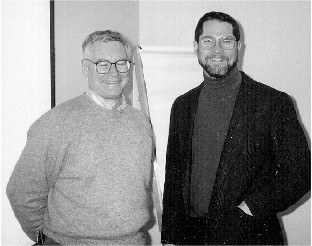
EMCS President Dan Hoolihan (L) has perfected the art of sleeping
while standing up!
Actually, President Hoolihan was in town to attend the Oregon and
Southwest Washington EMC Chapter meeting in November with Dr. Howard Johnson (R).
We caught him with his eyes closed! (Sorry Dan!)
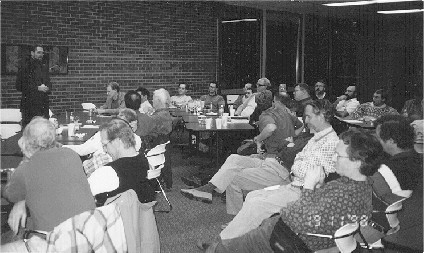
A last minute room change was required at the November Oregon and
Southwest Washington EMC Chapter meeting to accommodate the 48 attendees.
Obviously the speaker, Dr. Howard Johnson (standing on the left),
is quite popular in the Pacific Northwest. As such, he was invited to be a part of the
"Fundamentals of EMC" tutorial on August 2 in conjunction with the
1999 IEEE International Symposium on EMC in Seattle.
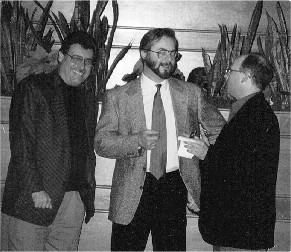
Enjoying the Oregon and Southwest Washington
EMC Chapter December Holiday Social
at the Harborside Restaurant are Chapter Officers (L-R)
Jerry Page of Northwest EMC, Charlie Tohlen of Tektronix and
Dan Arnold of Underwriters Laboratories, Inc.

Those spied enjoying a delicious three-course dinner at the Oregon
and Southwest Washington
EMC Chapter December Holiday Social are (L-R) Dan Arnold, Avis and Dan Horjus
("the Dans" are with Underwriters Laboratories), and Henry and Jackie Benitez.
The popular Chapter Chairman Henry is with Tektronix.
Dick Ford was the guest speaker in January. He gave an excellent presentation on Navy EMC excellence programs. February 17, the guest speaker will be Hans Peter- Bauer, from Rohde&Schwarz - Germany. He will discuss EMC measurement techniques. An EMC Colloquium and Vendor Exhibition will be held April 12 in Portland. The Colloquium was very successful in 1997. This year five speakers will be featured. Four of the speakers are members of the IEEE EMCS Board of Directors. For more information, contact Henry Benitez at 503-627-1217 or h.benitez@ieee.org.
Michael Daniele reports that Dr. William Duff, a Senior Consulting Engineer with Computer Sciences Corporation, presented “Electromagnetic Interference (EMI): The Nemesis of Medical Electronics” at the IEEE Night Philadelphia Section Meeting, at the University of Pennsylvania on November 17, 1998. His presentation addressed the problems associated with EMI in medical electronics and identified methods and techniques that may be used to design medical electronic equipment for electromagnetic compatibility.
The Phoenix EMC Society Chapter has officially been resurrected from its dormant status much like the legendary bird. Many thanks go to Daryl Gerke of Kimmel Gerke Associates, Ltd. who has been instrumental in reorganizing the Phoenix chapter and reinstituting its status. Glen Gassaway of Motorola and Terry Donohoe of Honeywell were also ringleaders in getting the chapter going again. We have now had four meetings over the past year with some excellent speakers and an attendance averaging about 30 people.
Daryl was unable to line up a speaker for the fall meeting so he “volunteered” to present a talk that has been well received at several other EMC Society Chapters. The audience learned “How To Design To Fail FCC & CISPR In 20 Easy Steps”, a tongue-in-cheek presentation that dealt with a number of serious EMC design problems. In this talk we learned of 20 ways to increase our radiated and conducted emissions including the concept of using the fastest clocks available and laying their circuit traces out to maximize the loop area!
The Phoenix EMC Society Chapter will be sponsoring an EMC Mini-Symposium on May 3, 1999 in the Phoenix area. The keynote speaker will be Henry Ott, a renowned expert in the field of EMC. There will also be about 10 to 30 exhibitors demonstrating their latest test equipment and EMC control products. The cost of the one-day symposium is expected to be about $125 for early registrations.
For information on the Phoenix EMC Society chapter, contact Mr. Daryl Gerke, phone (602) 755-0080 (dgerke@emiguru.com) or Mr. Harry Gaul, phone (602) 441-5321 (p19850@email.mot.com).
James Youngman reports that the Pikes Peak Chapter held two meetings during the fall of 1998. Mr. Dick Coulombe of INTERTest, a Colorado Springs product safety and EMC testing firm, provided an overview of general EMC emissions and immunity requirements for the US and European markets. INTERTest is the first (and only) independent organization which can provide such testing services for manufacturers in the Pikes Peaks region. The second meeting featured Mr. Neil Yosinski of Hewlett Packard, who gave a very interesting presentation on radiated emissions design, not from a purely technical perspective, but rather from an organizational “how-to” vantage. To ensure EMC success, the activities of many groups (management, electrical and mechanical engineering, PCB design, testing, etc.) must be effectively structured and managed.
In October the Rocky Mountain Chapter welcomed Distinguished Lecturer Bob Dockey of Hewlett Packard to our meeting at NIST. Bob shared his EMC experience in a lively discussion of “New Techniques for Reducing Printed Circuit Board Common-Mode Radiation”.
In December, the Chapter wrapped up the 1998 program with our Vendor Night and chapter elections. Chapter chair, Lyle Luttrell, reports that the turnout was good with a dozen vendors and over thirty society members, including EMC Society President Dan Hoolihan and the 1998 Symposium Chair Barry Wallen. Dan provided a summary of current international activities in the EMC Society, and Barry gave a recap of the 1998 EMC Symposium. The new chapter officers are:
Chairman – Lyle Luttrell (lluttrell@ieee.org)
Vice-chairman - Charles Grasso (chasgrasso@ieee.org)
Secretary - Bob Reinert (r.reinert@ieee.org)
Treasurer - John Stadille (jstadille@ball.com)
The 1999 Chapter program will focus on providing the regional technical community with more valuable EMC training and education. We are committed to providing industry with a program of solid technical content so that the cost of EMC can be reduced. Our program plans will be available at our NEW web site. The URL is: https://www.ewh.ieee.org/r5/denver/rockymountainemc/
The 1999 Rocky Mountain Chapter EMC Colloquium will be held in May; the date and program will be set soon.
The December meeting of the Santa Clara Valley chapter featured Neven Pischl of Bay Networks. Neven’s topic was “A New Common-Mode Voltage Probe for Predicting EMI from Unshielded Differential-Pair Cables.” His talk described a method for predicting EMI levels from unshielded differential twisted-pair cables using a common-mode voltage measurement.
EMCS Distinguished Lecturer, Don Bush, was the featured speaker at the January meeting. Over 100 people turned out to hear Don’s presentation on “Spread Spectrum Clock Techniques.”
In October, the Seattle EMC Chapter held a special four-hour training from 4:00 pm to 8:00 pm in lieu of its traditional one hour evening meeting. The training was held at CKC Labs in Redmond. Chris Kendall of CKC Labs spoke on “EMC Emissions Measurements: Getting the Right Answer.” The training included practical engineering and troubleshooting techniques while addressing conducted and radiated emissions. Demonstrations of the material presented were conducted in the lab for small groups. There was no fee for the training and certificates of completion were provided. A 45-minute dinner break for complimentary pizza and soft drinks kept everyone fresh for the duration of the evening. Some 50 chapter members attended and took advantage of this unique EMC event. The chapter resolved to hold one training a year since this event was so popular.
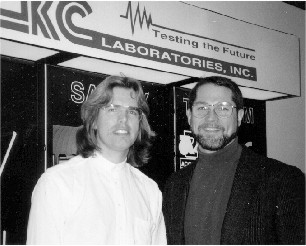
The November meeting of the Seattle EMC chapter featured speaker
Howard Johnson (R).
The topic “Why Digital Designers Don’t Believe in EMC” enticed Erik Godo
(L)
of Boeing to attend his first EMC chapter meeting. Erik is the Chairman of the
Seattle chapter of IEEE’s Circuits and Systems Society.
In November, Dr. Howard Johnson spoke to the Seattle EMC Chapter on the topic, “Why Digital Designers Don’t Believe in EMC.” Based in Redmond, this “local hero” held the audience in a trance with his energetic, professional presentation. In fact, despite the fact that this was an evening meeting, chapter members wished that Dr. Johnson would have stayed and spoken longer!
Howard Johnson, Ph.D, is the author of High-Speed Digital Design: A Handbook of Black Magic (Prentice-Hall, 1993). One chapter member brought this book to the meeting for Dr. Johnson to personally autograph! Dr. Johnson explained that whether they recognize it or not, many engineers with a purely digital background have a difficult time dealing with EMC problems. In fact, the underlying, root cause of many of our present day difficulties with EMC is a matter of attitude: digital engineers don’t believe in EMC.
Without intending any harm, our institutions, vendors, and managers have propagated five great misconceptions which prevent many, if not most, new digital designers from understanding EMC at any level, and in fact, from even believing in its existence. Dr. Johnson advised that the better you understand these five great misconceptions, the better equipped you will be to understand the point of view of many digital engineers, and to help them overcome the EMC difficulties they will inevitably face. He discussed these misconceptions and other issues of importance to both EMC and digital design engineers during his presentation.

Chris Kendall (L) receives "payment" of one pound of
"Seattle's Best"
coffee from Chapter Chairman Ghery Pettit for his services as speaker
at a special four-hour training held at the October Seattle EMC Chapter meeting.
Chris donated his time and considerable talent to speak to the chapter on
"EMC Emissions Measurements: Getting the Right Answer".
Dr. Johnson will be participating as a speaker during the “Fundamentals of EMC” tutorial to be held on August 2, 1999 in conjunction with the 1999 IEEE International Symposium on Electromagnetic Compatibility in Seattle. Chapter members present at the meeting immediately marked their calendars to save the date for a future local presentation by Dr. Johnson.
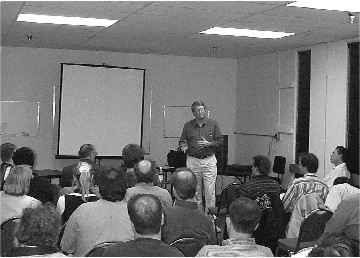
Seattle EMC Chapter Chairman Ghery Pettit welcomes the crowd to the
October Chapter meeting. After completing the four-hour EMC training,
some 50 chapter members received a certificate signed by the instructor,
Chris Kendall, and the Chapter Chairman.
The Seattle Chapter is also busy planning a special event to be held on August 1, 1999 at the Crowne Plaza Hotel in downtown Seattle. Clayton R. Paul will present a one day tutorial entitled “Introduction to Electromagnetic Compatibility.” This event is designed for those new to EMC and it will be the perfect “prep class” for those attending the IEEE EMC Symposium the following week at the Washington State Convention and Trade Center in downtown Seattle. You can find more information about the tutorial, including a registration form, on the chapter’s web page at https://home1.gte.net/joecool/ieee/. This event is expected to sell out so register early if you are interested in attending.
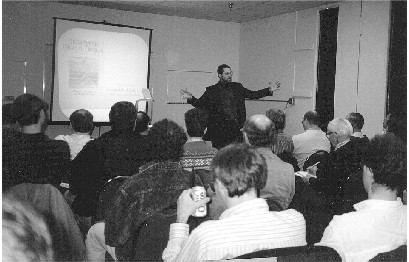
Howard Johnson speaks to a packed audience at the November
Seattle EMC Chapter meeting. Some 45 people attended the meeting at
CKC Labs and used every chair available!
For more information about the Seattle EMC Chapter, visit the chapter’s web page as noted above, or link to it from the EMC Society web page. Everyone is welcome at the chapter meetings! If you plan to be in the Seattle area, visit the web page and come to a meeting.